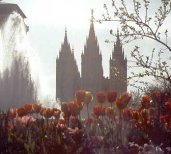LDS and FLDS: Kindred Spirits
The Aspen Times is celebrating its 125th anniversary. In conjunction with the Aspen Historical Society, the newspaper is printing some old stories that have appeared throughout its history. The following story was printed in The Aspen Times in 1885:
Pugnacious Mormons
Our dispatches this morning announce that the Mormons have determined to test the constitutionality of the Tennessee law which makes the preaching of polygamy a misdemeanor. Three Mormon elders were arrested on Saturday in Carter county in that state and a suit to test the law will grow out of it. This indicates that the Mormon heresy must have gained a strong foothold in that state. It is a commentary upon the condition of public education in Tennessee, for it is a well known fact that the Mormon missionaries are successful in obtaining converts only among the ignorant and debased.
I don't know if this harsh commentary is more insulting to Mormonism or to Tennessee, but it's interesting to see that the issue of Mormon polygamy in the 19th century was not confined to Utah Territory. No wonder the citizens of the United States were concerned about it.
You may be tired of reading about polygamy; it's been in the news so much lately. I've not been terribly interested in the subject myself. After all, it's got 100 years' worth of distance from Mormonism (officially). But as Warren Jeffs and the FLDS Church have received so much media coverage in recent months, I have realized that the LDS Church and the FLDS Church share much more than just historical Mormon polygamy.
Yesterday an article appeared in Salt Lake City Weekly, "Once a Creeker." It's the story of Margaret Cook, an ex-FLDS member and former polygamous wife who left Colorado City twelve years ago for a better life. Though lengthy, the article reveals much about the emotions and behaviors growing out of spiritual bondage. I would encourage anyone interested in Mormon culture to read it.
Let me explain the connection.
Margaret Cook has experienced terrible things in her lifetime, both as an FLDS member and as an ex-member. The things that have been done to her in the name of religion are unconscionable. I do not suggest that the Mormon Church engages in the same behavior as that which has been perpetrated against Margaret Cook; however, I have experienced similar but much less intense actions directed at me by Mormons.
For instance, while Margaret has had pot-shots taken at her, when I've been engaged in legal Christian outreach near LDS sites I have had rocks thrown at me. I have been followed and photographed by LDS security. My actions have been discussed between Mormon officials with walkie-talkies. I've been falsely accused. I've been harassed by Mormon police. I've had close-calls when LDS members have wanted to frighten me with their cars. I've been flashed lewd hand gestures. And the list could go on.
My point is not that I've been victimized. These same things happen to my co-workers in ministry as well. After 17 years I recognize that it just comes with the territory. But what I find interesting are the similarities in the mindsets of both the FLDS and LDS people: the deep suspicion of outsiders; the determination to control every situation; the attitude of being above (or outside) the law; the active hostility toward critics; the use of intimidation against "undesirables." Where does all this come from?
The Bible tells us that the fruit of the Spirit is "love, joy, peace, longsuffering. kindness. goodness, faithfulness, gentleness, [and] self-control" (Galatians 5:22-23). Conversely, the works of the flesh are "lewdness, …hatred, contentions, …outbursts of wrath, selfish ambitions, dissensions, heresies, …and the like" (Galatians 5:19-20).
Take the time to read the Salt Lake City Weekly article. It's very revealing.








